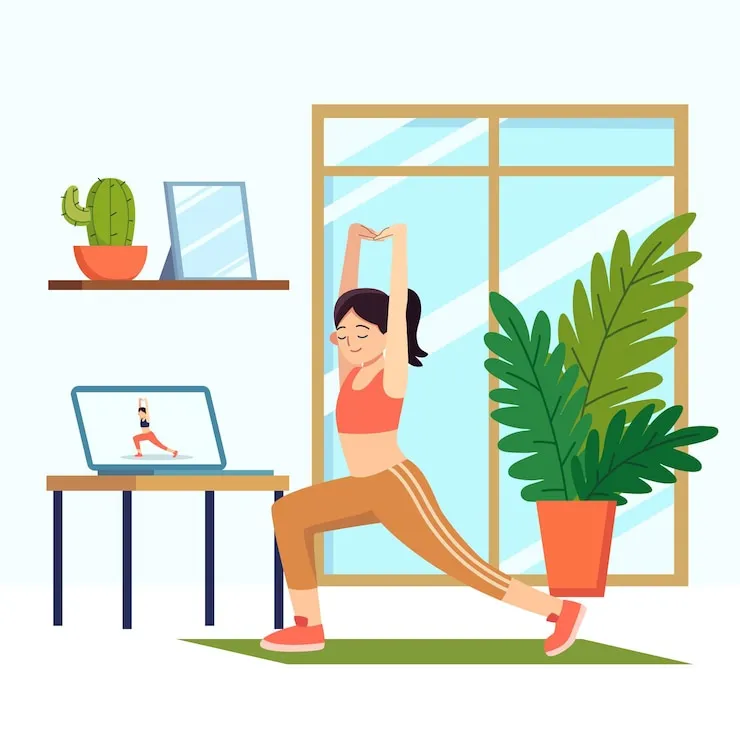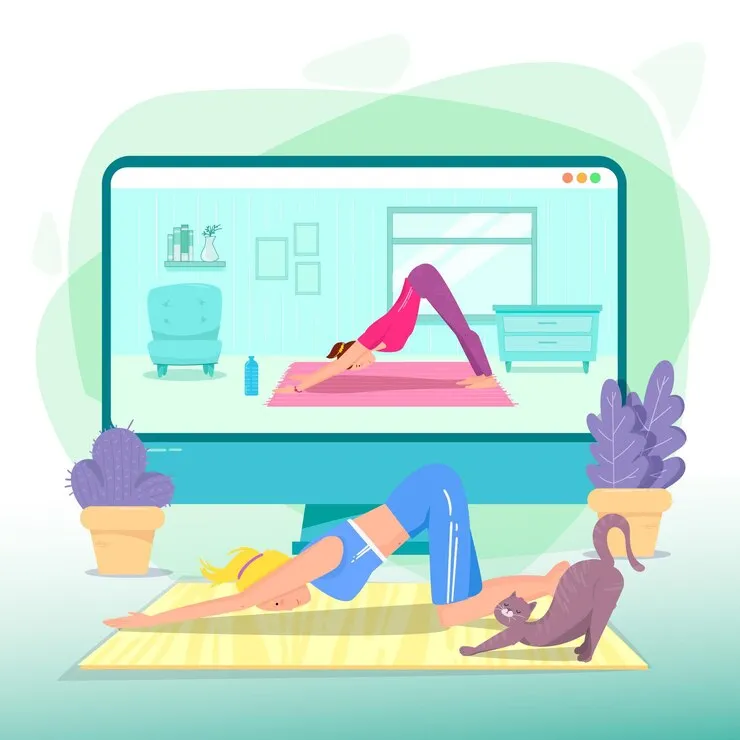30 Moves to Make the Most of Your At-Home Workout

Staying Active at Home Can Be Just as Good as the Gym—If You Know How Hey.
If you’ve ever looked at your living room and thought, “No way I can get fit here,” trust me — I thought the same. Years ago, my idea of exercise at home was lifting chips to my mouth. Then lockdown hit, my gym locked its doors, and suddenly my only option was that patch of carpet between the couch and the coffee table.
Turns out, staying active at home can actually be just as good as the gym — if you know how to approach it and stick to it. I had to learn this the hard way, through a lot of trial, error, and sore muscles. But once I found what worked, it changed everything.
So here’s what I wish someone had handed me back then: a clear, honest list of 30 moves you can do anywhere, anytime, with no fancy equipment. They keep your body strong, your mind clear, and your energy high — even if your dog keeps interrupting you halfway through.
Let’s break it down together
Why Bother With Home Workouts Anyway?
First off, staying active at home saves you money, time, and a whole lot of excuses. No driving across town. No waiting for that one machine everyone loves. No wiping off someone else’s sweat (which is truly one of life’s worst tasks).
You can work out in old pajamas or your favorite college T-shirt. You can play music as loud or as embarrassing as you want — I once did lunges to boy band songs and I regret nothing. You can pause to check your phone guilt-free, or flop on the floor dramatically mid-workout because nobody’s judging.
For me, home workouts became a stress-buster and sanity-saver, especially during endless Zoom calls and workdays that felt twice as long. Once you start seeing results — more energy, better sleep, stronger muscles — it becomes addictive in the best way.
How to Use This Guide
I’ve split the moves into three sections: Beginner, Intermediate, and Advanced. Start wherever feels comfortable. You can stick to one level or mix and match depending on your mood and energy that day.
The only real rule: respect your body. Focus on doing each move properly instead of trying to do a hundred sloppy reps. Good form means better results and fewer injuries.
Always Warm Up First

I once skipped warming up because I thought, “I’ll be fine. I’m strong enough.” Two lunges later, I pulled a muscle in my thigh and couldn’t bend down properly for days. Lesson learned.
Before you jump into the moves, take 5 to 10 minutes to warm up: arm circles, big shoulder rolls, gentle leg swings, or just march in place. Get your joints loose and your blood flowing. Your future self will appreciate it.
Beginner Moves (1 to 10)
Jumping Jacks — Simple, effective cardio. I often do these while my tea brews in the morning. Stand tall, jump your feet wide, clap hands overhead, jump feet back together. Repeat for 30 to 60 seconds.
Wall Sit — Great for building leg strength and testing your patience. Slide down a wall until your thighs are parallel to the floor. Keep your back pressed flat. Hold for 20 to 40 seconds.
Bodyweight Squat — Your go-to move for legs and glutes. Stand with feet shoulder-width apart, push hips back like sitting on an invisible chair, then stand up tall.
Standing Calf Raises — Strengthens ankles and calves, improves balance. Stand straight, lift your heels off the ground, pause, then lower slowly.
Modified Push-Up — Start on your knees if you can’t do a full push-up yet. Hands shoulder-width apart on the floor, lower your chest to the ground, push back up.
Step-Ups — Find a sturdy step, bench, or stairs. Step one foot up, bring the other foot up, step down, and repeat. Great for legs and balance.
Glute Bridge — Lie on your back, knees bent, feet flat. Lift your hips while squeezing your glutes, then lower slowly. Strengthens your backside and lower back.
Knee Plank — A gentle intro to building core strength. Rest on your forearms and knees, keep your back straight and abs tight. Hold for 20 to 30 seconds.
Standing Side Leg Raises — Strengthens hips and outer thighs. Stand tall, lift one leg out to the side, lower, and repeat. Switch sides.
Arm Circles — Simple warm-up or finisher. Extend your arms straight out and make small, controlled circles, then gradually make them bigger. Do both forward and backward.
Intermediate Moves (11 to 20)
Standard Push-Up — The classic chest and arm strengthener. Keep your body straight, lower your chest until your elbows are at 90 degrees, push back up.
Mountain Climbers — Excellent for cardio and core. Get into push-up position and drive your knees toward your chest alternately as quickly as you can.
Reverse Lunge — Easier on the knees than a forward lunge. Step one leg backward, bend both knees to about 90 degrees, then push back up to standing. Alternate legs.
Triceps Dips — Sit on the edge of a sturdy chair, place hands next to hips, slide hips off the seat, bend elbows to lower your body, push back up.
High Knees — Stand tall and jog in place, lifting your knees as high as possible. Gets your heart rate up quickly.
Side Plank — Great for working the obliques (side abs). Lie on your side, rest on one forearm, lift hips so your body forms a straight line. Hold for 20 to 40 seconds per side.
Squat Pulse — Lower into a squat, stay low, and pulse up and down a few inches. Burns the legs and glutes quickly.
Superman — Lie face down, arms extended in front. Lift arms and legs off the ground at the same time, hold briefly, lower back down. Strengthens lower back and glutes.
Bicycle Crunch — Lie on your back, hands behind your head. Bring opposite elbow to opposite knee, switch sides like pedaling a bicycle.
Single-Leg Deadlift — Improves balance and works hamstrings. Stand on one leg, hinge forward at hips while extending the other leg back, reach hands toward the floor, then return to standing.
Advanced Moves (21 to 30)

Burpee — The king of full-body exercises. From standing, squat down, jump feet back to push-up position, do a push-up, jump feet forward, then jump up explosively. Repeat.
Plyometric Push-Up — Do a push-up but push hard enough so your hands leave the floor. Land softly and repeat. Adds power to upper body strength.
Pistol Squat — One-leg squat. Hold onto a door frame or sturdy surface if needed. Extend one leg forward, squat down slowly on the other leg, then stand up.
Jump Squat — Do a regular squat, but explode upward into a jump. Land softly back into squat position. Builds explosive power in the legs.
Decline Push-Up — Elevate your feet on a chair or step, hands on the floor. Perform a push-up. This shifts more weight to the upper chest and shoulders.
Plank to Push-Up — Start in forearm plank. One arm at a time, push up to full push-up position, then lower back down. Strengthens core and upper body.
Skater Jump — Leap sideways from one foot to the other, swinging arms for balance like a speed skater. Builds leg strength and agility.
Tuck Jump — Stand tall, jump up and tuck your knees toward your chest. Land softly and repeat. Great for cardio and explosive power.
Handstand Hold (Wall) — Face a wall, place hands on the ground, kick up carefully so your feet rest on the wall. Hold the position to build shoulder and core strength.
Plank Jacks — In plank position, jump your feet apart and back together like jumping jacks, but keep your upper body stable. Spices up a static plank with cardio.
Cool Down
Never skip your cool down. This is when you stretch out tight muscles, lower your heart rate, and calm your mind. I usually do gentle stretches for my hamstrings, quads, hips, back, shoulders, and finish by lying flat and taking slow, deep breaths. Some days, I even drift off for a quick nap right there on the mat — no shame.
A Few Real-World Tips
Focus on form more than counting reps. Good form protects you and helps you progress faster.
Keep a bottle of water close. Hydrate before, during, and after. I always forget until I’m completely parched.
If a move feels too hard or painful, modify it or switch to an easier version.
Rest is part of training. Take days off to recover — muscles rebuild when you sleep and rest.
Do what you can, when you can. A short, consistent routine beats an occasional marathon workout every single time.
Frequently Asked Questions (FAQs)
How many sets should I do?
If you’re new, start with one or two sets of each move. As you get stronger, increase to three or four sets.
Do I really need equipment?
No. Just your body and a little bit of space. A chair, a step, or a wall can make some moves easier or more challenging.
Can I change the exercises?
Yes. Feel free to swap any move for another. If burpees make you miserable, replace them with jump squats or mountain climbers. Make it work for you.
Final Thoughts
I promise you, you do not need a fancy gym membership or shiny machines to get fit and feel strong. I did all these moves in my tiny living room, surrounded by laundry piles and a very confused dog. It was far from glamorous, but it worked.
So start where you are, use what you have, and do what you can. One day, you’ll catch yourself doing push-ups you once thought were impossible — and you’ll thank your past self for ditching excuses and moving anyway.
Stay active, stay healthy, and have fun with it. You’ve got this.